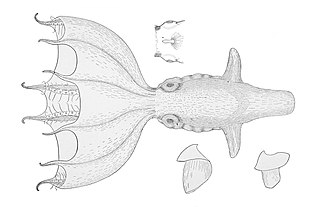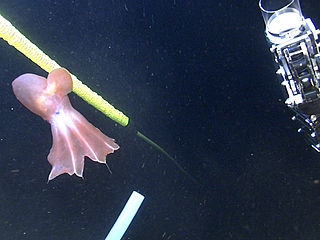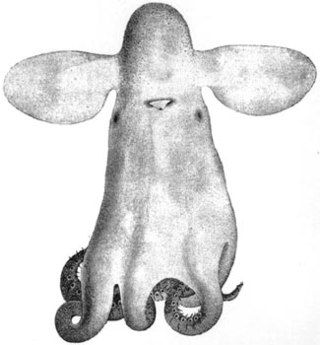
Cirroteuthidae is a family of pelagic cirrate octopuses comprising at least three species in two genera.

Grimpoteuthis is a genus of pelagic cirrate (finned) octopods known as the dumbo octopuses. The name "dumbo" originates from their resemblance to the title character of Disney's 1941 film Dumbo, having two prominent ear-like fins which extend from the mantle above each eye. There are 17 species recognized in the genus. Prey include crustaceans, bivalves, worms and copepods. The average life span of various Grimpoteuthis species is 3–5 years.
Luteuthis dentatus, also known as Lu's jellyhead, is a medium-sized species of cirrate octopus found in the southwestern Pacific, originally described by Steve O'Shea.

Umbrella octopuses are a group of pelagic octopuses. Umbrella octopuses are characterized by a web of skin between the arms, causing them to somewhat resemble an opened umbrella when the arms are spread.

Stauroteuthis is a genus of deepwater cirrate octopus, a cephalopod mollusk. This is the only genus in the family Stauroteuthidae, and only three species have been described in this genus.

Teuthology is the study of cephalopods. Cephalopods are members of the class Cephalopoda in the Phylum Mollusca. Some common examples of cephalopods are octopus, squid, and cuttlefish. Teuthology is a large area of study that covers cephalopod life cycles, reproduction, evolution, anatomy and taxonomy.

Incirrata is a suborder of the order Octopoda. The suborder contains the classic "benthic octopuses," as well as many pelagic octopus families, including the paper nautiluses. The incirrate octopuses are distinguished from the cirrate octopuses by the absence in the former of the "cirri" filaments for which the cirrates are named, as well as by the lack of paired swimming fins on the head, and lack of a small internal shell.

Octopodiformes is a superorder of the subclass Coleoidea, comprising the octopuses and the vampire squid. All living members of Octopodiformes have eight arms, either lacking the two tentacles of squid or modifying the tentacles into thin filaments. Octopodiformes is often considered the crown group of octopuses and vampire squids, including all descendants of their common ancestor. Some authors use the term Vampyropoda for the same general category, though others use "Vampyropoda" to refer to the total group. Another term is Octobranchia, referring to cephalopods without prominent tentacles.

Stauroteuthis syrtensis, also known as the glowing sucker octopus or bioluminescent octopus, is a species of small pelagic octopus found at great depths in the north Atlantic Ocean. It is one of a very small number of octopuses to exhibit bioluminescence.

Cirroteuthis muelleri, also known as the big-finned jellyhead, was the first cirrate octopus species to be scientifically described. It is closely related to the genus Cirrothauma within the family Cirroteuthidae. At present the genus contains a single recognized species restricted to the Arctic Ocean and northern basins of the Atlantic and Pacific, but other species may be present in the southern hemisphere.
Stauroteuthis gilchristi is a species of small pelagic octopus found at great depths in the south Atlantic Ocean. It is believed to be one of a very small number of octopuses to exhibit bioluminescence, like its sister taxon Stauroteuthis syrtensis.

Cirrate octopuses possess a well-developed internal shell that supports their muscular swimming fins. This is in contrast to the more familiar, finless, incirrate octopuses, in which the shell remnant is either present as a pair of stylets or absent altogether.

Argonautoidea is a superfamily of the suborder Incirrata containing all known argonautoids.
Cryptoteuthis brevibracchiata, the short-arm flapjack octopod, is a deepwater species of octopod. It is the only species in the monotypic genus Cryptoteuthis one of the cirrate octopuses of the family Grimpoteuthidae, the umbrella octopuses. It is known from a single specimen which was collected in the northeastern Atlantic Ocean. It has characteristics which are shared with two other genera, Opisthoteuthis and Grimpoteuthis, but is sufficiently distinctive from either of these to warrant the erection of a new genus.
Luteuthis is a small genus of cirrate octopuses currently placed in the family Grimpoteuthidae. There are two species classified in this genus one from waters west of New Zealand and the other from the South China Sea.
Grimpoteuthis innominata, commonly known as the small jellyhead, is a species of small, pelagic octopus described by Steve O'Shea in 1999 from two specimens, however several further specimens have since been identified. The genus Enigmateuthis was described to contain this species when described, but Martin Collins placed the species in the genus Grimpoteuthis due to uncertainty regarding the type specimen of Grimpoteuthis.

Opisthoteuthis agassizii is a lesser-known, deep-sea octopus first described in 1883 by Addison E. Verrill.
Opisthoteuthis bruuni is a species of finned cirrate octopus found along the western coast of South America. Their tissue is almost jelly-like, and they have short, round bodies.

The Teudopseina is a clade of stem-octopods that first evolved in the Toarcian, considered the largest clade of gladius-bearing coleoids in the Mesozoic. Up to five families are known, among which the Trachyteuthidae, Trachyteuthis in particular, were the most abundant.

Grimpoteuthidae are a family of bentho-pelagic octopuses, comprising three currently accepted genera. They have extensive arm webbing and relatively large fins allowing for powerful fin swimming.














